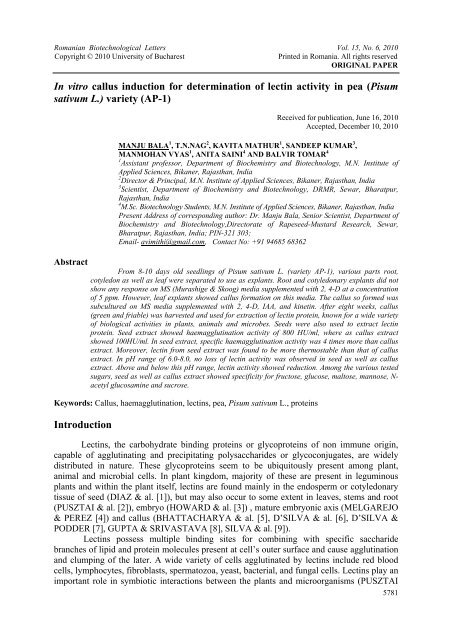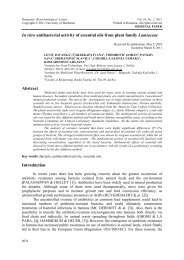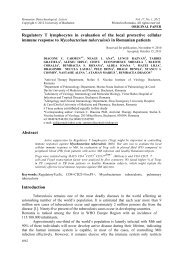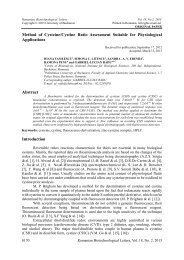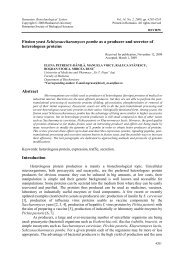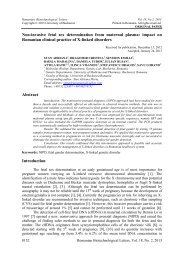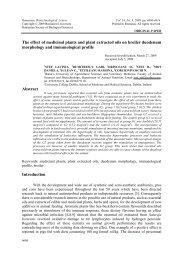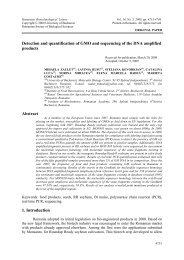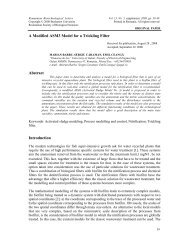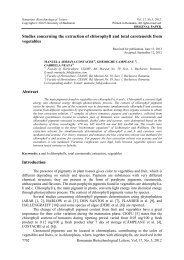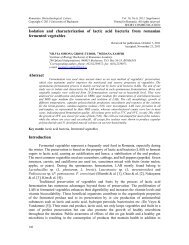(Pisum sativum L.) variety - Rombio.eu
(Pisum sativum L.) variety - Rombio.eu
(Pisum sativum L.) variety - Rombio.eu
Create successful ePaper yourself
Turn your PDF publications into a flip-book with our unique Google optimized e-Paper software.
Romanian Biotechnological Letters Vol. 15, No. 6, 2010<br />
Copyright © 2010 University of Bucharest<br />
Printed in Romania. All rights reserved<br />
ORIGINAL PAPER<br />
In vitro callus induction for determination of lectin activity in pea (<strong>Pisum</strong><br />
<strong>sativum</strong> L.) <strong>variety</strong> (AP-1)<br />
Abstract<br />
Received for publication, June 16, 2010<br />
Accepted, December 10, 2010<br />
MANJU BALA 1 , T.N.NAG 2 , KAVITA MATHUR 1 , SANDEEP KUMAR 3 ,<br />
MANMOHAN VYAS 1 , ANITA SAINI 4 AND BALVIR TOMAR 4<br />
1 Assistant professor, Department of Biochemistry and Biotechnology, M.N. Institute of<br />
Applied Sciences, Bikaner, Rajasthan, India<br />
2 Director & Principal, M.N. Institute of Applied Sciences, Bikaner, Rajasthan, India<br />
3 Scientist, Department of Biochemistry and Biotechnology, DRMR, Sewar, Bharatpur,<br />
Rajasthan, India<br />
4 M.Sc. Biotechnology Students, M.N. Institute of Applied Sciences, Bikaner, Rajasthan, India<br />
Present Address of corresponding author: Dr. Manju Bala, Senior Scientist, Department of<br />
Biochemistry and Biotechnology,Directorate of Rapeseed-Mustard Research, Sewar,<br />
Bharatpur, Rajasthan, India; PIN-321 303;<br />
Email- avimithi@gmail.com, Contact No: +91 94685 68362<br />
From 8-10 days old seedlings of <strong>Pisum</strong> <strong>sativum</strong> L. (<strong>variety</strong> AP-1), various parts root,<br />
cotyledon as well as leaf were separated to use as explants. Root and cotyledonary explants did not<br />
show any response on MS (Murashige & Skoog) media supplemented with 2, 4-D at a concentration<br />
of 5 ppm. However, leaf explants showed callus formation on this media. The callus so formed was<br />
subcultured on MS media supplemented with 2, 4-D, IAA, and kinetin. After eight weeks, callus<br />
(green and friable) was harvested and used for extraction of lectin protein, known for a wide <strong>variety</strong><br />
of biological activities in plants, animals and microbes. Seeds were also used to extract lectin<br />
protein. Seed extract showed haemagglutination activity of 800 HU/ml, where as callus extract<br />
showed 100HU/ml. In seed extract, specific haemagglutination activity was 4 times more than callus<br />
extract. Moreover, lectin from seed extract was found to be more thermostable than that of callus<br />
extract. In pH range of 6.0-8.0, no loss of lectin activity was observed in seed as well as callus<br />
extract. Above and below this pH range, lectin activity showed reduction. Among the various tested<br />
sugars, seed as well as callus extract showed specificity for fructose, glucose, maltose, mannose, N-<br />
acetyl glucosamine and sucrose.<br />
Keywords: Callus, haemagglutination, lectins, pea, <strong>Pisum</strong> <strong>sativum</strong> L., proteins<br />
Introduction<br />
Lectins, the carbohydrate binding proteins or glycoproteins of non immune origin,<br />
capable of agglutinating and precipitating polysaccharides or glycoconjugates, are widely<br />
distributed in nature. These glycoproteins seem to be ubiquitously present among plant,<br />
animal and microbial cells. In plant kingdom, majority of these are present in leguminous<br />
plants and within the plant itself, lectins are found mainly in the endosperm or cotyledonary<br />
tissue of seed (DIAZ & al. [1]), but may also occur to some extent in leaves, stems and root<br />
(PUSZTAI & al. [2]), embryo (HOWARD & al. [3]) , mature embryonic axis (MELGAREJO<br />
& PEREZ [4]) and callus (BHATTACHARYA & al. [5], D’SILVA & al. [6], D’SILVA &<br />
PODDER [7], GUPTA & SRIVASTAVA [8], SILVA & al. [9]).<br />
Lectins possess multiple binding sites for combining with specific saccharide<br />
branches of lipid and protein molecules present at cell’s outer surface and cause agglutination<br />
and clumping of the later. A wide <strong>variety</strong> of cells agglutinated by lectins include red blood<br />
cells, lymphocytes, fibroblasts, spermatozoa, yeast, bacterial, and fungal cells. Lectins play an<br />
important role in symbiotic interactions between the plants and microorganisms (PUSZTAI<br />
5781
MANJU BALA, T.N.NAG, KAVITA MATHUR, MANMOHAN VYAS, ANITA SAINI,<br />
BALVIR TOMAR AND SANDEEP KUMAR<br />
[10]), plant defense and stress physiology, carbohydrate metabolism and packaging of storage<br />
proteins (ETZLER [11], KIJNE & al. [12], SHARON & LIS [13], SHUKLA & al. [14]).<br />
Lectins are also known to exhibit a wide <strong>variety</strong> of biological activities in animals (SONI &<br />
al. [15]). Lectins have been tested for their toxicity and may be useful as anticancer drugs<br />
(OPPENHEIMER & al. [16]) and anti HIV agent (NAEEM & al. [17]).<br />
Lectins from leguminous seeds are among the most extensively studied plant lectins.<br />
Lectins found in legume seeds constitute a family of related proteins sharing structural and<br />
amino acid sequence homologies (SHARON & LIS [18]). Typically, these lectins are<br />
glycoproteins consisting of subunits with molecular masses in a range of 25 to 35 KD<br />
arranged as dimers or tetramers. These are particularly abundant in legume seeds, accounting<br />
as much as 10 % of the total seed protein (ETZLER [11]). The seed lectins accumulate in<br />
protein storage vacuoles of cotyledons and are degraded during seed germination as well as<br />
maturation of the seedlings (PUSZTAI [10]). Pea seeds as well as seedling parts i.e. root,<br />
shoot etc. have already been reported to contain lectins (DIAZ & al. [1], VAN DRIESSCHE<br />
& al. [19], BAJAJ & SONI [20]). In general, vegetative lectins are present at much lower<br />
levels than those of seed and also have not been characterized as well. Although some<br />
vegetative lectins possess strong homologies with seed lectins, others display unusual<br />
carbohydrate- binding characteristics and an in-ability to agglutinate erythrocytes (PUSZTAI<br />
[10], ETZLER [11]).<br />
Plant tissue and cell cultures could be an alternative continuous source of lectins and<br />
could also be a useful and important tool to study their regulation and biosynthesis. Although<br />
in vitro production of lectin from different sources have been reported (BHATTACHARYA<br />
& al. [5], D’SILVA & al. [6], D’SILVA & PODDER [7], GUPTA & SRIVASTAVA [8],<br />
SILVA & al. [9]) and callus using different explants has been raised using different hormonal<br />
combinations in grass pea (Lathyrus sativus L) (OCHATT & al. [21]) and pea (<strong>Pisum</strong> <strong>sativum</strong><br />
L.) (SHARMA & KAUSHAL [22], SIDHU & DAVIES [23]). But there are a few/ no reports<br />
regarding the studies on lectins in callus cultures of pea plants. So present study has been<br />
undertaken to establish tissue cultures of pea (<strong>Pisum</strong> <strong>sativum</strong> L.) <strong>variety</strong> (AP-1) and screening<br />
of these for presence of lectins along with seeds .The interest in the present study is based on<br />
the fact that lectins have been employed in various biotechnology applications and callus<br />
cultures could represent a convenient system to obtain and purify considerable amounts of<br />
lectins.<br />
Material and Methods<br />
Seed sample:<br />
The seeds of pea (<strong>Pisum</strong> <strong>sativum</strong> L.) <strong>variety</strong> AP-1 were obtained from Agriculture<br />
Research Station, Beechwal, Rajasthan Agriculture University, Bikaner.<br />
Rabbit blood:<br />
Rabbit Blood used for making RBC suspension required for haemagglutination study<br />
was procured from National Research Centre on Camel (NRCC), Bikaner, Rajasthan, India.<br />
Explant preparation<br />
Seeds were first washed thoroughly under flowing tap water, followed by several<br />
washings with solution of liquid detergent and sterile distilled water. Seeds were then treated<br />
with 0.1 % HgCl 2 for 2 to 3 minutes followed by treatment with bevistin and then rinsed 3 to<br />
4 times with sterile distilled water. Paper bridges were prepared with filter paper strips taken<br />
in test tubes with their ends soaked in distilled water and autoclaved for 15 to 20 minutes.<br />
Surface sterilized seeds were aseptically inoculated on the paper bridges. From 8-10 days old<br />
5782 Romanian Biotechnological Letters, Vol. 15, No. 6, 2010
In vitro callus induction for determination of lectin activity in pea (<strong>Pisum</strong> <strong>sativum</strong> L.) <strong>variety</strong> (AP-1)<br />
seedlings, roots, leaves and cotyledons were excised aseptically and used as explants for<br />
inoculation on MS medium.<br />
Culture media and conditions<br />
The explants were transferred to MS media (MURASHIGE & SKOOG [24])<br />
containing 3% (w/v) sucrose and 0.8% (w/v) agar. MS medium was supplemented with 5 ppm<br />
2,4-D. pH of media was adjusted to 5.8 prior to autoclaving at 121°C and 1.05 kg/cm square<br />
(15 psi) pressure for 15 –20 minutes. After inoculation, culture vessels were labeled and kept<br />
in culture chamber. The culture chamber had aseptic uniform conditions of temperature 26±<br />
2°C, 55±5% relative humidity (RH) and diffused light (300 lux).<br />
Harvesting of callus tissues<br />
The callus thus obtained was maintained by frequent sub-culturing after 4-6 weeks on<br />
fresh MS medium supplemented with 2, 4-D (1.5 ppm), IAA (0.5 ppm) and kinetin (0.5 ppm).<br />
The tissues samples so grown were harvested regularly after 8 weeks for further biochemical<br />
analysis.<br />
Biochemical Evaluation of Callus and Pea seeds<br />
Extraction of lectins and determination of haemagglutination activity along with<br />
protein content<br />
The lectins were extracted from the pea seeds and callus tissues using normal saline<br />
(0.9 % sodium chloride). The crude extract obtained was used for determination of<br />
haemagglutination activity and protein content. The haemagglutination activity of lectin<br />
extract was assayed by serial dilution technique of LIENER & HILL [25], whereas protein<br />
was estimated by the method of LOWRY & al. [26].<br />
Thermostability of pea lectins<br />
In order to determine the thermostability, the lectin extracts were incubated at different<br />
temperatures i.e. 40, 50, 60, 70 and 80°C for 30 minutes. The extracts were brought to room<br />
temperature and activity was determined by serial dilution technique using rabbit erythrocytes.<br />
Lectin stability under different pH conditions<br />
To study the stability of lectins in media having different pH, phosphate buffer saline<br />
(PBS) with pH range of 5.0-9.0 (pH tolerated by rabbit erythrocytes) was prepared. The<br />
haemagglutination assay was carried out by mixing 0.1 ml of each extract in 0.9 ml of PBS<br />
with pH 5.0, 5.5, 6.0, 6.5, 7.0, 7.5, 8.0, 8.5 and 9.0. The agglutination assay was run by using<br />
PBS of the respective pH for the two fold serial dilution as well as for control.<br />
Sugar specificity<br />
Sugar specificity of lectins was determined by finding the inhibition of agglutination<br />
activity by different sugars. For this purpose, 0.5 ml of the last dilution preparation showing<br />
positive agglutination and 0.1 ml of sugar solution of known molarities were mixed. After<br />
incubation for 2 h at room temperature, 0.4 ml of 2% rabbit erythrocytes suspension was<br />
mixed with each mixture and observed for haemagglutination. Negative agglutination<br />
indicated the specificity for that sugar. Different sugars tested were arabinose, cellobiose,<br />
fructose, galactose, glucose, lactose, maltose, mannose, melibiose, N-acetyl galactosamine,<br />
N-acetyl glucosamine, ribose and sucrose.<br />
Statistical analysis<br />
Statistical analysis was performed using Excel 2007 and data was expressed as mean<br />
±Standard Deviation of three replicates.<br />
Results and discussion<br />
Among various seedling parts used as explants on MS media supplemented with 2, 4-<br />
D (5ppm), root and cotyledons explants did not show any response whereas the leaf explants<br />
showed hypertrophy after inoculation. After 8-10 days of hypertrophy, hyperplasia was<br />
Romanian Biotechnological Letters, Vol. 15, No. 6, 2010 5783
MANJU BALA, T.N.NAG, KAVITA MATHUR, MANMOHAN VYAS, ANITA SAINI,<br />
BALVIR TOMAR AND SANDEEP KUMAR<br />
observed. Callus was observed along the midrib and margins of leaf. Complete callusing of<br />
explant was observed after 25-30 days of inoculation. The callus so obtained was greenish<br />
white in color.<br />
This callus was sub-cultured on MS media supplemented with 2, 4-D (1.5ppm), IAA<br />
(0.5ppm) and kinetin (0.5ppm). After 8 weeks, green and friable tissues were harvested.<br />
SHARMA & KAUSHAL [22] observed callus induction in pea on MS medium containing 2,<br />
4-D (2mg/l) when used leaf, epicotyls and root as explants. They also reported more callus<br />
formation from leaf explant for the various hormonal combinations tested by them. The callus<br />
produced from leaf explants in the present study was friable in nature and similar observation<br />
has also been reported by SHARMA & al. [27].<br />
Lectins were extracted from the seeds and callus tissues of pea (pisum <strong>sativum</strong> L.)<br />
<strong>variety</strong> (AP-1) using normal saline. The crude extract from seed showed haemagglutination<br />
activity of 800 HU/ml. The protein content was found to be 9.49 (mg/ml) and the specific<br />
haemagglutination activity of seed extract was 84.30 (Table1). In case of pea, lectin has<br />
already been reported in mature seeds by BAJAJ & SONI [20].The perusal of data in Table 1<br />
revealed that haemagglutination activity in callus tissues was also detected but it was low<br />
(100 HU/ml) as compared to seed extract activity.<br />
Table 1. Haemagglutination activity, protein content and specific haemagglutination activity of seed and callus<br />
extract of <strong>Pisum</strong> <strong>sativum</strong> L. <strong>variety</strong> AP-1<br />
Sample<br />
Haemagglutination activity<br />
HU/ml<br />
Protein<br />
mg/ml<br />
Specific activity<br />
HU/mg protein<br />
Seed extract 800 9.49 ±0.11 84.30 ±0.98<br />
Callus extract 100 4.42 ±0.03 22.59 ±0.16<br />
Each value is mean ±SD of three determinations.<br />
Protein content was 4.42 (mg/ml) and the specific haemagglutination activity was<br />
found to be 22.59 HU/mg protein. The results revealed that seed extract showed 4 times more<br />
specific haemagglutination activity than the callus extract. Whereas, SILVA & al. [9] reported<br />
that the specific haemagglutinating activity from crude callus extract (2.4 HU /mg) was<br />
comparable to that obtained from seeds (3.2 HU/ mg). Similarly, GUPTA & SRIVASTAVA<br />
[8] reported much higher haemagglutination activity in callus of Zizyphus mauritiana than<br />
its seeds. But in the present study, pea callus was found to be having less haemagglutination<br />
activity as compared to seeds. BHATTACHARYA & al. [5] also reported very less<br />
haemagglutinating activity of lectins during in vitro lectin production from Abrus cultures.<br />
Thermostability test revealed that lectin activity in seed and callus extracts was present<br />
up to 70⁰ C and 50 0 C, respectively. HOWARD & SAGE [28] showed that Lens culinaris<br />
lectin was stable up to 65 0 C. In our results, lectin from callus was found to be more<br />
thermolabile as compared to seed lectin as shown in Table 2.<br />
Table 2. Thermostability of lectins extracted from seed and callus extract of Pea (<strong>Pisum</strong> <strong>sativum</strong> L) Variety AP-1<br />
Exposure<br />
Haemagglutination activity (HU/ml)<br />
temperature (ºC)<br />
Seed extract<br />
Callus extract<br />
HU/ml % activity HU/ml % activity<br />
37 800 100* 100 100*<br />
40 800 100 100 100<br />
50 512 64 64 64<br />
60 256 32 ND ND<br />
70 128 16 ND ND<br />
80 ND ND ND ND<br />
Each value is mean ±SD of three determinations.<br />
ND Not detected<br />
Activity of preparation incubated at 37 ˚C was taken as 100 %<br />
5784 Romanian Biotechnological Letters, Vol. 15, No. 6, 2010
In vitro callus induction for determination of lectin activity in pea (<strong>Pisum</strong> <strong>sativum</strong> L.) <strong>variety</strong> (AP-1)<br />
Data from Table 3 revealed that there was no loss of lectin activity in seed as well as<br />
callus extract at pH range of 6.0-8.0, whereas at pH below 6.0 and above 8.0 there was<br />
reduction in activity. The pH sensitivity of Zizyphus mauritiana and Abrus spp. callus lectin<br />
also lies in the pH range 6.0 and 7.6 (GUPTA & SRIVASTAVA [8], SILVA & al. [9]).<br />
Table 3. Stability of lectins at different pH media<br />
Haemagglutination activity (HU/ml)<br />
pH<br />
Seed extract<br />
Callus extract<br />
HU/ml % activity HU/ml % activity<br />
5.0 512 64 64 64<br />
5.5 512 64 64 64<br />
6.0 800 100 100 100<br />
6.5 800 100 100 100<br />
7.0 800 100* 100 100*<br />
7.5 800 100 100 100<br />
8.0 800 100 100 100<br />
8.5 512 64 64 64<br />
9.0 512 64 64 64<br />
Each value is mean ±SD of three determinations.<br />
* Activity at pH 7.0 was taken as 100%<br />
Sugars which are specific for pea seed and callus lectins and which inhibited lectin<br />
mediated haemagglutination are listed in Table 4.<br />
Table 4. Inhibition of pea lectin mediated haemagglutination by different sugars<br />
Sugars tested *<br />
Haemagglutination activity<br />
Seed extract callus extract<br />
Arabinose + +<br />
Cellobiose + +<br />
Fructose - -<br />
Galactose + +<br />
Glucose - -<br />
Lactose + +<br />
Maltose - -<br />
Mannose - -<br />
Melibiose + +<br />
N-acetylgalactosamine + +<br />
N-acetylglucosamine - -<br />
Ribose + +<br />
Sucrose - -<br />
Each value is mean ±SD of three determinations.<br />
Maximum concentration of sugars tested was 0.1M<br />
+ haemagglutination<br />
-<br />
haemagglutination inhibition<br />
It is evident from results that fructose, glucose, maltose, mannose, N-acetyl<br />
glucosamine and sucrose inhibited lectin activity of seed as well as callus extract showing<br />
they are glucose/mannose specific. Similar kind of results has been observed by other workers<br />
in other varieties and different parts of pea (BAJAJ & SONI [20],). Similarly, PUSZTAI [10]<br />
and ETZLER [11] had also reported that some vegetable lectins possess strong homologies<br />
with seed lectins.<br />
Conclusions<br />
From the present study it is concluded that pea callus raised from leaf explants is<br />
friable in nature. The cotyledon and root explants did not give rise to callus formation under<br />
Romanian Biotechnological Letters, Vol. 15, No. 6, 2010 5785
MANJU BALA, T.N.NAG, KAVITA MATHUR, MANMOHAN VYAS, ANITA SAINI,<br />
BALVIR TOMAR AND SANDEEP KUMAR<br />
our tested conditions. Lectin activity was detected from pea callus although activity was far<br />
less than that of pea seeds. It was found to be thermolabile as compared to pea seed lectin but<br />
it performed similar to seed lectin with different sugars and under different pH media.<br />
Acknowledgements<br />
Authors are thankful to Secretary, M N Institute of Applied Sciences, Bikaner for<br />
providing necessary facilities, Agriculture Research Station, Beechwal, Rajasthan Agriculture<br />
University, Bikaner for providing seeds and National Research Centre on Camel (NRCC),<br />
Bikaner, Rajasthan, India for providing blood samples for this study.<br />
References<br />
1. C.L.DIAZ, , H M.OSSELET, , G.J.J. LOGMAN, E. VAN DRIESSCHE, B.J. LUGTENBERG, , J.W.<br />
KIJNE, Distribution of glucose/ mannose specific isolectins in pea (<strong>Pisum</strong> <strong>sativum</strong>) seedlings. Planta,<br />
181,451-461(1990).<br />
2. A. PUSZTAI, R.R.D. CROY, G. GRANT, J.C. STEWART , Seed proteins, J. DAUSSANT, J MOSSE, J<br />
VAGHAN eds., Academic Press, New York, 1983.<br />
3. I.K.HOWARD, H.J. SAGE, C.B. HORTAN, Studies on the appearance and location of hemeagglutinins<br />
from a common lentil during the lifecycle of the plant. Arch. Biochem. Biophys., 149, 323-326 (1972).<br />
4. L.M.MELGAREJO, G. PEREZ, Immunolocalization of the lectins p2 and p4 from Dioclea lehmanni seeds.<br />
Plant cell physiol., 38, 480-483(1997).<br />
5. P.S. BHATTACHARYA, T.K. MAITI, B.C. BHATTACHARYA, Tissue culture of Abrus precatorius and<br />
in vitro Abrus lectin production: A new report. In: Proceedings of the Bio/Technology Winter Symposium,<br />
Maime I, 34 (1992).<br />
6. I.D’SILVA, C.S. VAIDYANATHAN, S.K. PODDER, Ribosome-inactivating proteins and agglutinins from<br />
callus and suspension cultures of Ricinus communis L. and Abrus precatorius L. Plant Sci., 94,161–172<br />
(1993).<br />
7. I.D’SILVA, S.K. PODDER, Peanut agglutinin from callus and cell suspension cultures of Arachis hypogae<br />
L. Plant Cell, 14, 50–54 (1994).<br />
8. N. GUPTA, P.S. SRIVASTAVA, Purification and characterization of a lectin from seeds and cotyledonary<br />
callus of Zizyphus mauritiana. Plant Cell Rep., 17: 552-556 (1998).<br />
9. A.L.C. SILVA, A.C.G. HORTA, R.A. MOREIRA, L.M. BELTRAMINI, A.P.U. ARAUJO, Production of<br />
Abrus pulchellus ribosome- inactivating protein from seeds callus culture .Toxicon., 41, 841-849(2003).<br />
10. A. PUSZTAI, Plant Lectins, Cambridge University Press, New York, 1991.<br />
11. M.E. ETZLER, Distribution and function of plant lectins. In: The Lectins: Properties, Functions, and<br />
Applications in Biology and Medicine, I.E. LIENER, N.SHARON, I.J GOLDSTEIN, eds., Academic Press,<br />
Orlando, 1986, pp. 371-435.<br />
12. J.W.KIJNE, G.SMIT, C.L.DÍAZ, B.J.J. LUGTENBERG, The physiological function of lectins. In:<br />
Recognition in microbe-plant symbiotic and pathogenic interaction, G LUGTENBERG ed., Springer-Verlag,<br />
KG, Berlin, 1986, pp. 101-111.<br />
13. N. SHARON, H. LIS, Lectins as cell recognition molecules. Sci., 246, 227-234 (1989).<br />
14. S. SHUKLA, R. ARORA, H.C. SHARMA, Biological activity of Soybean trypsin inhibitor and plant lectins<br />
against cotton bollworm/legume pod borer Helicoverpa armiagera (Noctuidae:Lepidoptera). Plant Biotech.<br />
22,1-6 (2005).<br />
15. G.L. SONI, S. KINGER, S. VADHERA, R. Singh, Intraperitoneal toxicity of pea and lentil lectins in albino<br />
rats-effect on growth and osmotic fragility of erythrocytes. Ind. J. Expt. Biol., 29, 280–281(1991).<br />
16. S.B. OPPENHEIMER, M. ALVAREZ, J. NNOLI, Carbohydrate-based experimental therap<strong>eu</strong>tics for cancer,<br />
HIV/AIDS and other diseases. Acta Histochem., 110, 6-13(2008).<br />
17. A. NAEEM, M. SALEEMUDDIN, R.H. KHAN, Glycoprotein targeting and other applications of lectins in<br />
biotechnology. Curr. Proteins Pept. Sci., 8, 261-271(2007).<br />
18. N. SHARON, H. LIS, Legume lectins-A large family of homologous proteins. FASEB J., 4, 3198-3208<br />
(1990).<br />
19. E. VAN DRIESSCHE, S. BEECKMANS, L. KANAREK, Maturation of pea lectin a comparison with other<br />
leguminosae lectins. In: Recent advances of research on antinutritional factors in legume seeds, J.<br />
HUISMAN , T.F.B. VANDER POEL, I.E. LIENER, eds., Pudoc, Wegeningen, 1989, pp.67-72.<br />
5786 Romanian Biotechnological Letters, Vol. 15, No. 6, 2010
In vitro callus induction for determination of lectin activity in pea (<strong>Pisum</strong> <strong>sativum</strong> L.) <strong>variety</strong> (AP-1)<br />
20. M. BAJAJ, G. SONI, Haemagglutition (lectin) activity in germinating pea (<strong>Pisum</strong> <strong>sativum</strong> L.) seedlings. Adv.<br />
Biosci., 19,103-116 (2000).<br />
21. S.J. OCHATT, P. DURIEU, L. JACAS, C. PONTECAILLE, Protoplast, Cell and tissue cultures for the<br />
biotechnological breeding of grass peas Lathyrus. Newslett., 2, 35-38 (2001).<br />
22. R. SHARMA, R.P. KAUSHAL, Generation and characterization of pea (<strong>Pisum</strong> <strong>sativum</strong>) somaclones for<br />
resistance to Ascochyta blight and powdery mildew . Indian J. Biotech., 3, 400-408 (2004).<br />
23. P. SIDHU, P. DAVIES, Pea Anther culture callus Initiation and production of haploid plants. In:<br />
Contributing to a Sustainable future, I.J. BENNET, E. BUNN, H. CLARKE, J.A. MCCOMB eds., Procs<br />
Australian Branch IAPTC & B, Perth, Western Australia, 2005.<br />
24. T. MURASHIGE, F. SKOOG, A revised medium for rapid growth cultures and bioassays with tobacco<br />
tissue. Physiol. Plant., 15,473-497(1962).<br />
25. I.E. LIENER, E.G. HILL, The effect of heat treatment on the nutritive value and hemeagglutinin activity of<br />
soybean oil meal. J. Nutr., 49, 609(1953).<br />
26. O.H. LOWRY, N.J. ROSEBROUGH, A.L. FARR, R.J. RANDALL, Protein measurement with the Folin<br />
phenol reagent. J. Biol. Chem., 193, 265–275(1951).<br />
27. T.R. SHARMA, B.M. SINGH, P.D. TYAGI, C. LAL, In Vitro regeneration of plants in <strong>Pisum</strong> <strong>sativum</strong> and<br />
their reaction to Ascochytes pinodes. Proc. Ind. Natl. Sci. Acad. Biol. Sci., 62, 359-366 (1996).<br />
28. I.K.HOWARD, H.J. SAGE, Isolation and characterization of a phytohemagglutinin from the lentil.<br />
Biochem., 8: 2435-2441(1969).<br />
Romanian Biotechnological Letters, Vol. 15, No. 6, 2010 5787


